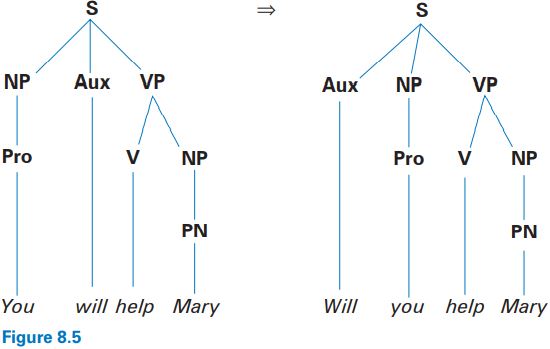


 Grammar
Grammar
 Tenses
Tenses
 Present
Present
 Past
Past
 Future
Future
 Parts Of Speech
Parts Of Speech
 Nouns
Nouns
 Verbs
Verbs
 Adverbs
Adverbs
 Adjectives
Adjectives
 Pronouns
Pronouns
 Pre Position
Pre Position
 Preposition by function
Preposition by function 
 Preposition by construction
Preposition by construction
 Conjunctions
Conjunctions
 Interjections
Interjections
 Grammar Rules
Grammar Rules
 Linguistics
Linguistics
 Semantics
Semantics
 Pragmatics
Pragmatics
 Reading Comprehension
Reading Comprehension|
Read More
Date: 10-8-2022
Date: 2023-11-02
Date: 4-2-2022
|
Movement rules
The very small set of phrase structure rules just described is a sample of what a more complex phrase structure grammar of English, with many more parts, would look like. These rules can be treated as a representation of the underlying or deep structures of (1) S (6) S NP VP NP VP Art N V NP Pro V NP Art N Pro A dog followed the boy You saw it Figure 8.4 Syntax 103 sentences in English. One feature of these underlying structures is that they will generate sentences with a fixed word order. That is convenient for creating declarative forms (You will help Mary), but not for making interrogative forms, as used in questions (Will you help Mary?). In making the question, we move one part of the structure to a different position. This process is based on a movement rule.
In order to talk about this process, we need to expand our phrase structure rules to include an auxiliary verb (Aux) as part of the sentence. This is illustrated in the first rewrite rule below. Auxiliary verbs (sometimes described as “helping” verbs) take different forms in English, but one well-known set can be included in the rudimentary lexical rule for Aux below. We also need a lexical rule that specifies the basic forms of the verbs, shown as the third rewrite rule below.

With these components, we can specify a simple movement rule that is involved in the creation of one basic type of question in English.

This type of rule has a special symbol ⇒ and can be illustrated in the process of one tree, on the right, being derived from the tree on the left.

Using this simple rule, we can also generate these other questions:

These are all surface structure variations of a single underlying structure. However, we still have not incorporated recursion.
|
|
|
|
دخلت غرفة فنسيت ماذا تريد من داخلها.. خبير يفسر الحالة
|
|
|
|
|
|
|
ثورة طبية.. ابتكار أصغر جهاز لتنظيم ضربات القلب في العالم
|
|
|
|
|
|
|
قسم الشؤون الفكرية يعزز مكتبته بفهارس المخطوطات التركية
|
|
|